Synthesis of Micro-Electrolysis Composite Materials from Blast Furnace Dust and Application into Organic Pollutant Degradation
Abstract
:1. Introduction
2. Materials and Methods
2.1. Materials
2.2. Preparation and Experiment of Materials
2.3. Analysis and Characterization
3. Results and Discussion
3.1. Effects of Preparation Conditions on Organic Pollutant Degradation
3.2. Effects of Reaction Parameters on Organic Pollutant Degradation
3.3. Characterization and Mechanism of Organic Removal
4. Conclusions
Author Contributions
Funding
Institutional Review Board Statement
Informed Consent Statement
Data Availability Statement
Acknowledgments
Conflicts of Interest
References
- Ye, L.; Peng, Z.; Ye, Q.; Wang, L.; Augustine, R.; Perez, M.; Liu, Y.; Liu, M.; Tang, H.; Rao, M.; et al. Toward environmentally friendly direct reduced iron production: A novel route of comprehensive utilization of blast furnace dust and electric arc furnace dust. Waste Manag. 2021, 135, 389–396. [Google Scholar] [CrossRef]
- Xiao, X.; Zhang, S.; Sher, F.; Chen, J.; Xin, Y.; You, Z.; Wen, L.; Hu, M.; Qiu, G. A Review on Recycling and Reutilization of Blast Furnace Dust as a Secondary Resource. J. Sustain. Met. 2021, 7, 340–357. [Google Scholar] [CrossRef]
- Deng, X.; Huang, R.; Lv, X.; Yang, J.; Yang, J. Separation and recovery of metallic zinc and iron concentrate from blast furnace dust by vacuum carbothermal reduction. Process Saf. Environ. Prot. 2022, 162, 746–751. [Google Scholar] [CrossRef]
- Zhang, L.; Gao, Y.; Yue, Q.; Zhang, P.; Wang, Y.; Gao, B. Prepartion and application of novel blast furnace dust based catalytic-ceramic-filler in electrolysis assisted catalytic micro-electrolysis system for ciprofloxacin wastewater treatment. J. Hazard. Mater. 2019, 383, 121215. [Google Scholar] [CrossRef]
- Omran, M.; Fabritius, T. Utilization of blast furnace sludge for the removal of zinc from steelmaking dusts using microwave heating. Sep. Purif. Technol. 2018, 210, 867–884. [Google Scholar] [CrossRef]
- Zhuang, Q.; Zhou, R.; Li, G.; Zhang, Y.; Xiong, X.; Geng, S.; Zou, X.; Cheng, H.; Zhang, Y.; Xu, Q.; et al. Synergistic Preparation of Metalized Pellets Using Stainless-Steel Pickling Sludge and Blast-Furnace Bag Dust. Met. Mater. Trans. A 2022, 53, 1564–1582. [Google Scholar] [CrossRef]
- Cao, Y.-Y.; Duan, D.-P.; Zhou, E.; Sun, T.-C. The function of blast furnace dust as reductant on simultaneous reduction of high-phosphorus oolitic hematite. Ironmak. Steelmak. 2018, 47, 520–530. [Google Scholar] [CrossRef]
- Yehia, A.; El-Rahiem, F.H. Recovery and utilization of iron and carbon values from blast furnace flue dust. Miner. Process. Extr. Met. 2005, 114, 207–211. [Google Scholar] [CrossRef]
- Yang, S.; Zhao, M.; Li, J.; Feng, J.; Liu, Q. Removal of Zinc and Lead from Blast Furnace Dust in a Fluidized-Bed Roaster. J. Sustain. Met. 2017, 3, 441–449. [Google Scholar] [CrossRef]
- Luo, X.; Wei, C.; Li, X.; Deng, Z.; Li, M.; Fan, G. The use of carbon-dioxide to enhance the solvent extraction of zinc from ammonia leaching solutions of blast furnace dust. Hydrometallurgy 2020, 197, 105458. [Google Scholar] [CrossRef]
- Ding, L.; Ning, W.; Wang, Q.; Shi, D.; Luo, L. Preparation and characterization of glass–ceramic foams from blast furnace slag and waste glass. Mater. Lett. 2015, 141, 327–329. [Google Scholar] [CrossRef]
- Sultan, M.E.; Abo-El-Enein, S.A.; Sayed, A.Z.; El-Sokkary, T.M.; Hammad, H.A. Incorporation of cement bypass flue dust in fly ash and blast furnace slag-based geopolymer. Case Stud. Constr. Mater. 2018, 8, 315–322. [Google Scholar] [CrossRef]
- Shen, L.; Qiao, Y.; Guo, Y.; Tan, J. Preparation and formation mechanism of nano-iron oxide black pigment from blast furnace flue dust. Ceram. Int. 2013, 39, 737–744. [Google Scholar] [CrossRef]
- Matthaiou, V.; Oulego, P.; Frontistis, Z.; Collado, S.; Hela, D.; Konstantinou, I.K.; Diaz, M.; Mantzavinos, D. Valorization of steel slag towards a Fenton-like catalyst for the degradation of paraben by activated persulfate. Chem. Eng. J. 2018, 360, 728–739. [Google Scholar] [CrossRef]
- Wu, L.; Liao, L.; Lv, G.; Qin, F.; He, Y.; Wang, X. Micro-electrolysis of Cr (VI) in the nanoscale zero-valent iron loaded activated carbon. J. Hazard. Mater. 2013, 254–255, 277–283. [Google Scholar] [CrossRef] [PubMed]
- Li, X.; Zhou, L.; Zhuang, L.-L.; Zhang, J.; Li, M.; Yang, Y. High-efficient nitrogen and phosphorus removal and its mechanism in a partially unsaturated constructed wetland with Fe-C micro-electrolysis substrate. Chem. Eng. J. 2021, 431, 133252. [Google Scholar] [CrossRef]
- Cui, X.; Zhang, M.; Ding, Y.; Sun, S.; He, S.; Yan, P. Enhanced nitrogen removal via iron-carbon micro-electrolysis in surface flow constructed wetlands: Selecting activated carbon or biochar? Sci. Total Environ. 2022, 815, 152800. [Google Scholar] [CrossRef] [PubMed]
- Cheng, H.; Xu, W.; Liu, J.; Wang, H.; He, Y.; Chen, G. Pretreatment of wastewater from triazine manufacturing by coagulation, electrolysis, and internal microelectrolysis. J. Hazard. Mater. 2007, 146, 385–392. [Google Scholar] [CrossRef]
- Liu, Y.; Gao, Y.; Yao, B.; Zou, D. Removal of chlortetracycline by nano- micro-electrolysis materials: Application and mechanism. Chemosphere 2019, 238, 124543. [Google Scholar] [CrossRef]
- Malakootian, M.; Kannan, K.; Gharaghani, M.A.; Dehdarirad, A.; Nasiri, A.; Shahamat, Y.D.; Mahdizadeh, H. Removal of metronidazole from wastewater by Fe/charcoal micro electrolysis fluidized bed reactor. J. Environ. Chem. Eng. 2019, 7, 103457. [Google Scholar] [CrossRef]
- Wang, L.; Yang, Q.; Wang, D.; Li, X.; Zeng, G.; Li, Z.; Deng, Y.; Liu, J.; Yi, K. Advanced landfill leachate treatment using iron-carbon microelectrolysis- Fenton process: Process optimization and column experiments. J. Hazard. Mater. 2016, 318, 460–467. [Google Scholar] [CrossRef] [PubMed]
- Zhou, H.; Shen, Y.; Lv, P.; Wang, J.; Fan, J. Degradation of 1-butyl-3-methylimidazolium chloride ionic liquid by ultrasound and zero-valent iron/activated carbon. Sep. Purif. Technol. 2013, 104, 208–213. [Google Scholar] [CrossRef]
- Hu, Z.; Li, D.; Deng, S.; Liu, Y.; Ma, C.; Zhang, C. Combination with catalyzed Fe(0)-carbon microelectrolysis and activated carbon adsorption for advanced reclaimed water treatment: Simultaneous nitrate and biorefractory organics removal. Environ. Sci. Pollut. Res. 2019, 26, 5693–5703. [Google Scholar] [CrossRef] [PubMed]
- Ao, L.; Xia, F.; Ren, Y.; Xu, J.; Shi, D.; Zhang, S.; Gu, L.; He, Q. Enhanced nitrate removal by micro-electrolysis using Fe0 and surfactant modified activated carbon. Chem. Eng. J. 2018, 357, 180–187. [Google Scholar] [CrossRef]
- Han, Y.; Li, H.; Liu, M.; Sang, Y.; Liang, C.; Chen, J. Purification treatment of dyes wastewater with a novel micro-electrolysis reactor. Sep. Purif. Technol. 2016, 170, 241–247. [Google Scholar] [CrossRef]
- Peng, C.; Chen, L.; Wu, X.; Wei, X.; Tehrim, A.; Dai, M.; Xu, S. Identification of adsorption or degradation mechanism for the removal of different ionic dyes with iron-carbon micro-electrolysis process. J. Environ. Chem. Eng. 2021, 9, 105690. [Google Scholar] [CrossRef]
- Li, T.; Duan, Z.; Qin, R.; Xu, X.; Li, B.; Liu, Y.; Jiang, M.; Zhan, F.; He, Y. Enhanced characteristics and mechanism of Cu(II) removal from aqueous solutions in electrocatalytic internal micro-electrolysis fluidized-bed. Chemosphere 2020, 250, 126225. [Google Scholar] [CrossRef]
- Lai, B.; Zhou, Y.; Qin, H.; Wu, C.; Pang, C.; Lian, Y.; Xu, J. Pretreatment of wastewater from acrylonitrile–butadiene–styrene (ABS) resin manufacturing by microelectrolysis. Chem. Eng. J. 2012, 179, 1–7. [Google Scholar] [CrossRef]
- Han, Y.; Wu, C.; Su, Z.; Fu, X.; Xu, Y. Micro-electrolysis biological fluidized bed process for coking wastewater treatment. J. Water Process Eng. 2020, 38, 101624. [Google Scholar] [CrossRef]
- Song, N.; Xu, J.; Cao, Y.; Xia, F.; Zhai, J.; Ai, H.; Shi, D.; Gu, L.; He, Q. Chemical removal and selectivity reduction of nitrate from water by (nano) zero-valent iron/activated carbon micro-electrolysis. Chemosphere 2020, 248, 125986. [Google Scholar] [CrossRef]
- Ju, F.; Hu, Y. Removal of EDTA-chelated copper from aqueous solution by interior microelectrolysis. Sep. Purif. Technol. 2011, 78, 33–41. [Google Scholar] [CrossRef]
- Yang, S.; Sun, H.; Su, S.; Han, G.; Huang, Y. Fabrication, characterizations and performance of a high-efficiency micro-electrolysis filler for isobutyl xanthate (IBX) degradation. J. Hazard. Mater. 2020, 403, 123640. [Google Scholar] [CrossRef] [PubMed]
- Zhao, H.; Nie, T.; Zhao, H.; Liu, Y.; Zhang, J.; Ye, Q.; Xu, H.; Shu, S. Enhancement of Fe-C micro-electrolysis in water by magnetic field: Mechanism, influential factors and application effectiveness. J. Hazard. Mater. 2020, 410, 124643. [Google Scholar] [CrossRef] [PubMed]
- Wang, G.; Qian, L.; Yong, X.; Wang, Y.; An, W.; Jia, H.; Zhou, J. Synthesis of a ternary microscopic ball-shaped micro-electrolysis filler and its application in wastewater treatment. Sep. Purif. Technol. 2021, 275, 119131. [Google Scholar] [CrossRef]
- Yang, Z.; Ma, Y.; Liu, Y.; Li, Q.; Zhou, Z.; Ren, Z. Degradation of organic pollutants in near-neutral pH solution by Fe-C micro-electrolysis system. Chem. Eng. J. 2017, 315, 403–414. [Google Scholar] [CrossRef]
- Malakootian, M.; Mahdizadeh, H.; Khavari, M.; Nasiri, A.; Gharaghani, M.A.; Khatami, M.; Sahle-Demessie, E.; Varma, R.S. Efficiency of novel Fe/charcoal/ultrasonic micro-electrolysis strategy in the removal of Acid Red 18 from aqueous solutions. J. Environ. Chem. Eng. 2019, 8, 103553. [Google Scholar] [CrossRef]
- Cheng, G.; Zhang, Y.; Sun, L.; Wan, J.; Li, Z.; Dang, C.; Fu, J. Enhanced degradation of reactive brilliant red X-3B by photocatalysis integrated with micro-electrolysis. Environ. Sci. Pollut. Res. 2021, 28, 49899–49912. [Google Scholar] [CrossRef]
- Qin, L.; Zhang, G.; Meng, Q.; Xu, L.; Lv, B. Enhanced MBR by internal micro-electrolysis for degradation of anthraquinone dye wastewater. Chem. Eng. J. 2012, 210, 575–584. [Google Scholar] [CrossRef]
- Yu, W.; Sun, Y.; Lei, M.; Chen, S.; Qiu, T.; Tang, Q. Preparation of micro-electrolysis material from flotation waste of copper slag and its application for degradation of organic contaminants in water. J. Hazard. Mater. 2018, 361, 221–227. [Google Scholar] [CrossRef]
- Lu, C.; Sun, W.; Yue, T.; Han, H.; Yu, W.; Nguyen, A.V.; Wang, L. A way out of the alkaline bauxite residue: Synthesizing micro-electrolysis composite material towards the synergistic fenton degradation of high-concentration organic wastewater. J. Hazard. Mater. 2020, 400, 123210. [Google Scholar] [CrossRef]
- Liang, S.; Zhang, B.; Shi, J.; Wang, T.; Zhang, L.; Wang, Z.; Chen, C. Improved decolorization of dye wastewater in an electrochemical system powered by microbial fuel cells and intensified by micro-electrolysis. Bioelectrochemistry 2018, 124, 112–118. [Google Scholar] [CrossRef] [PubMed]



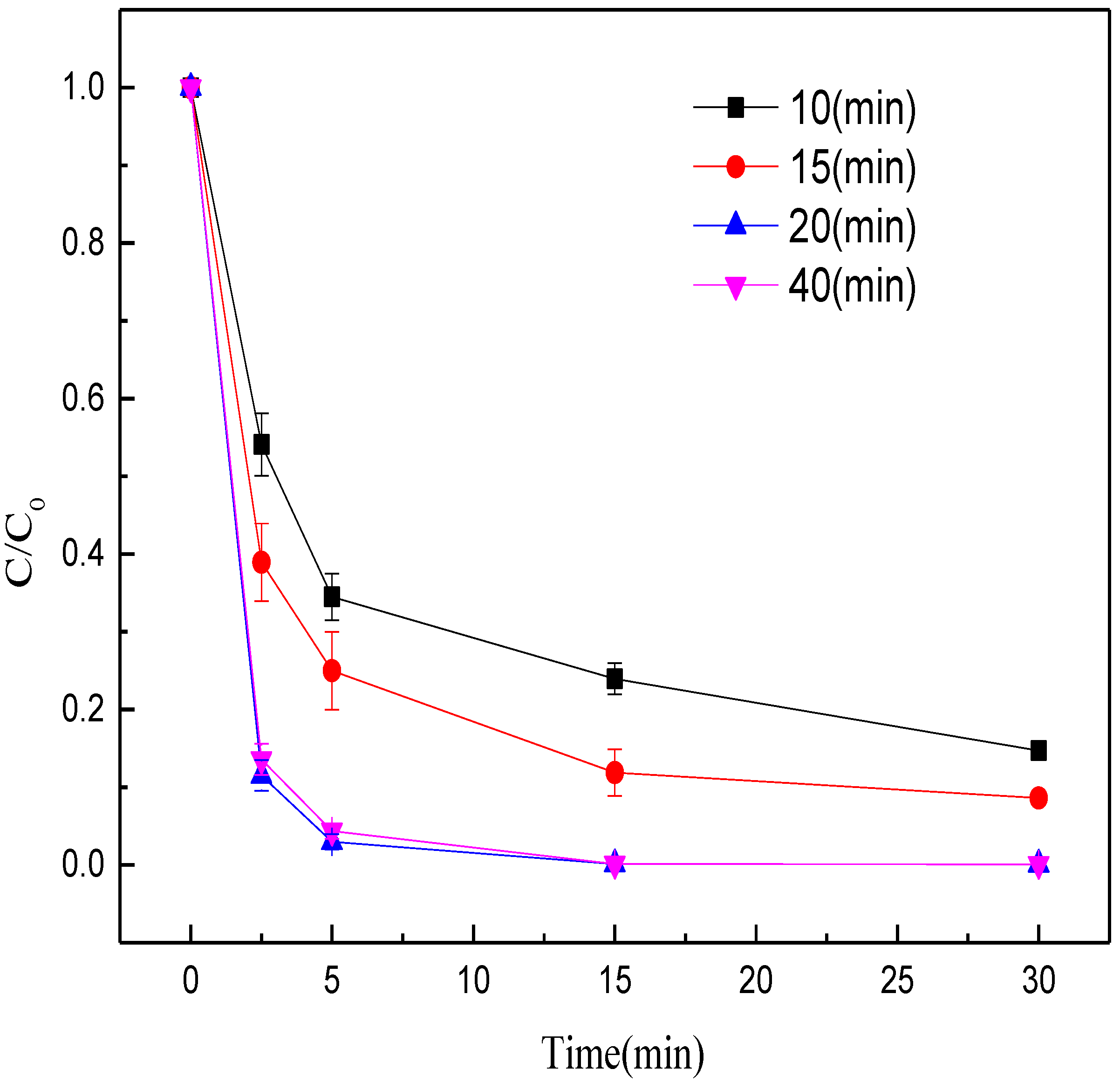
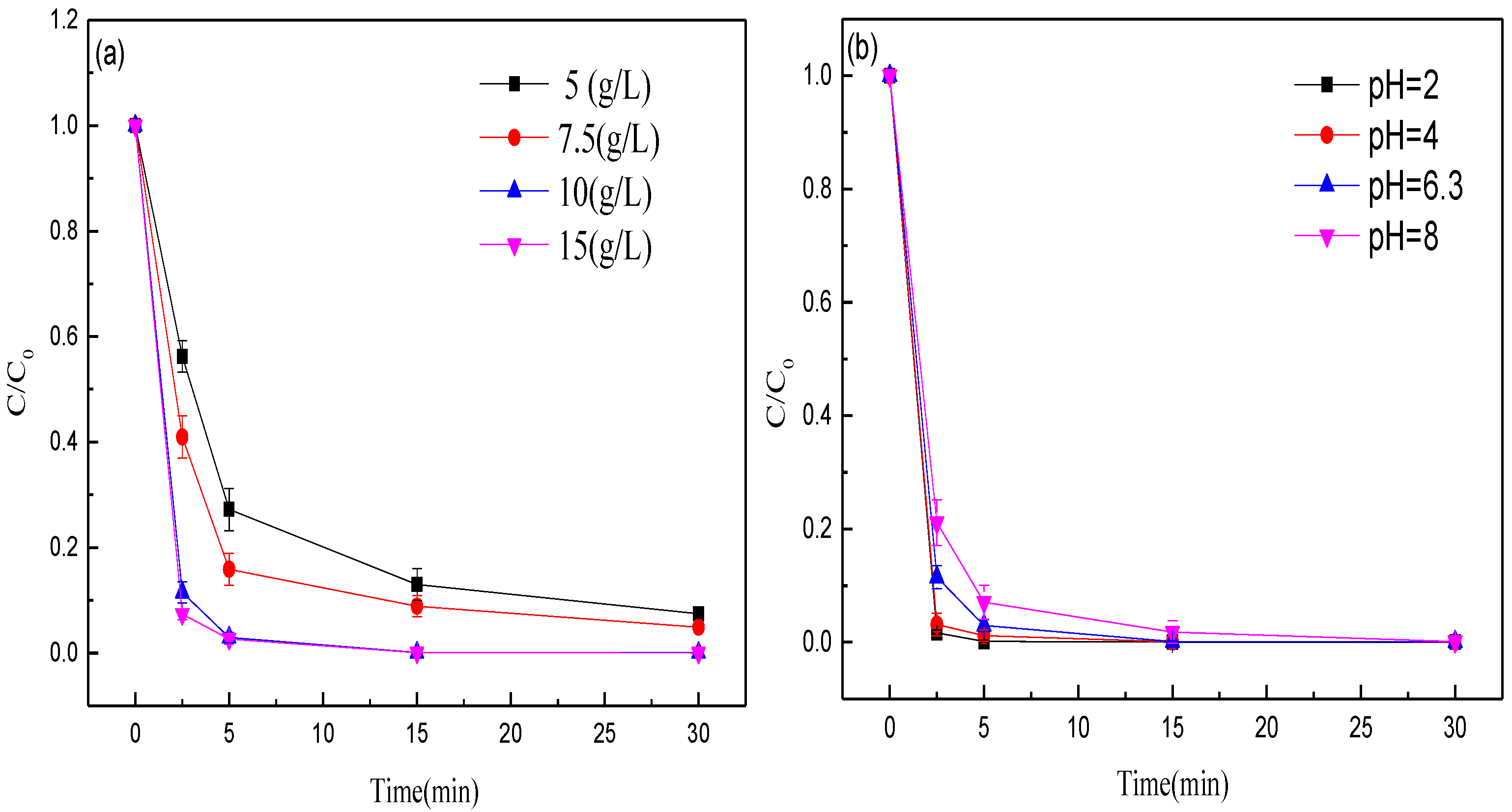
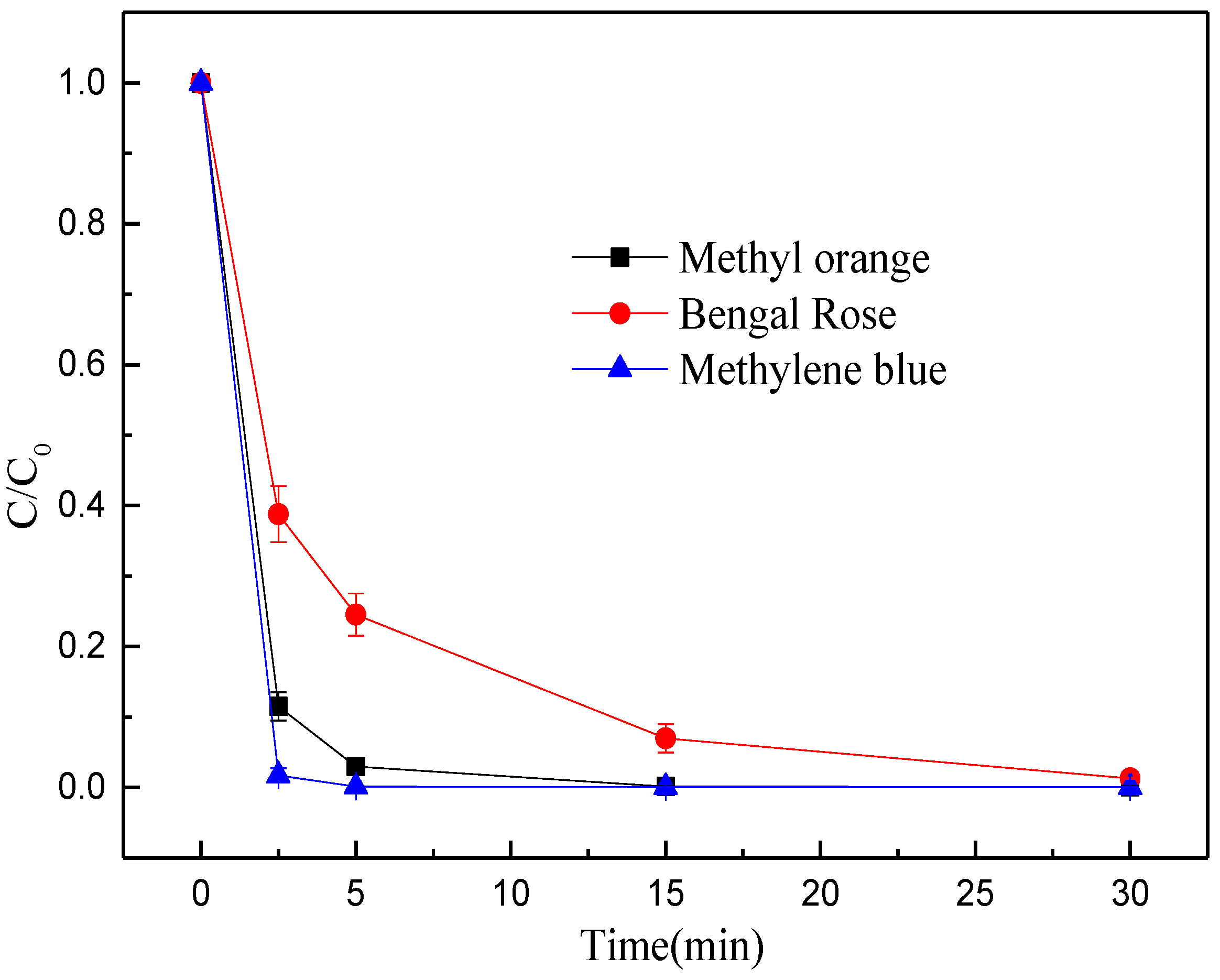
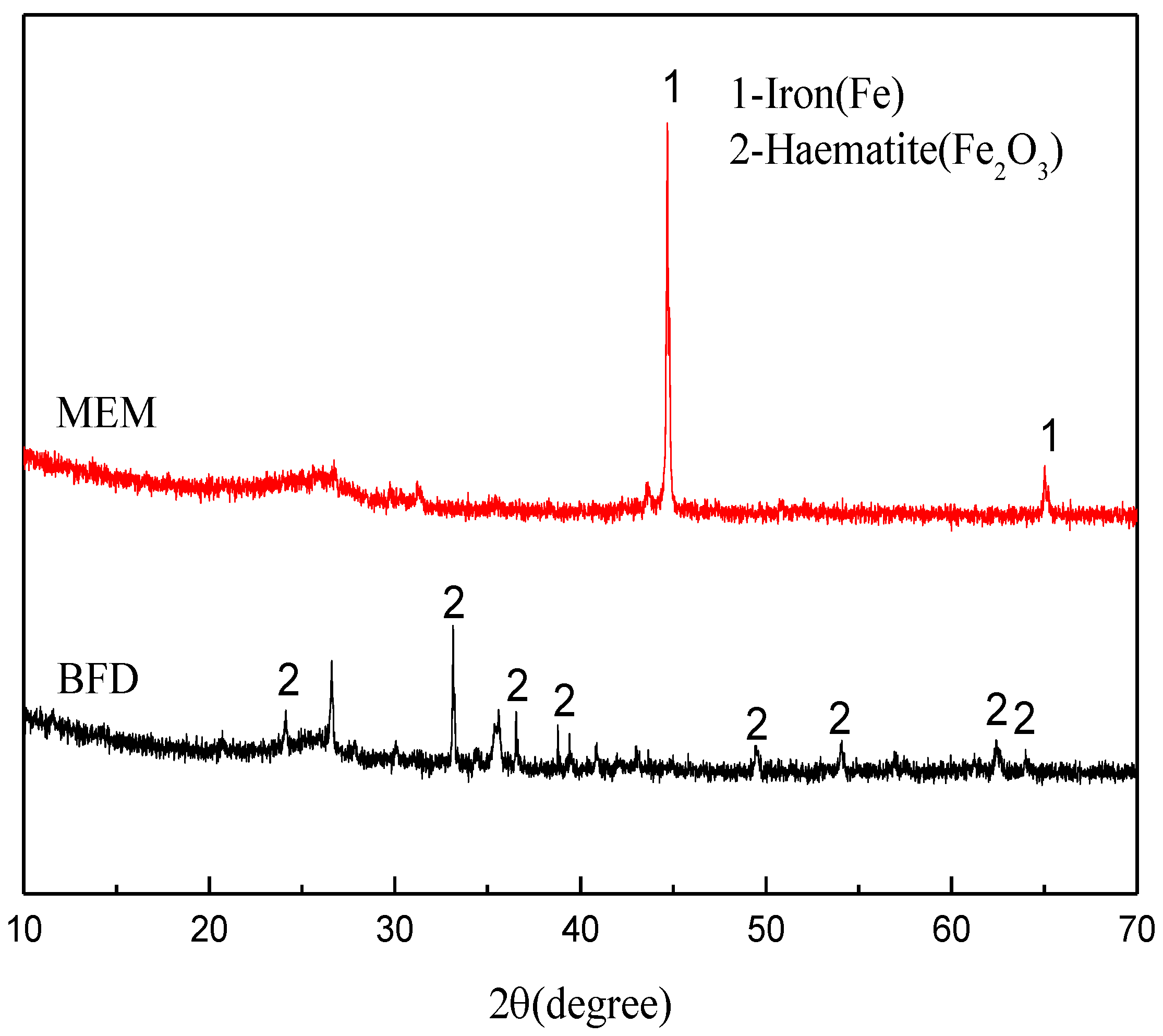
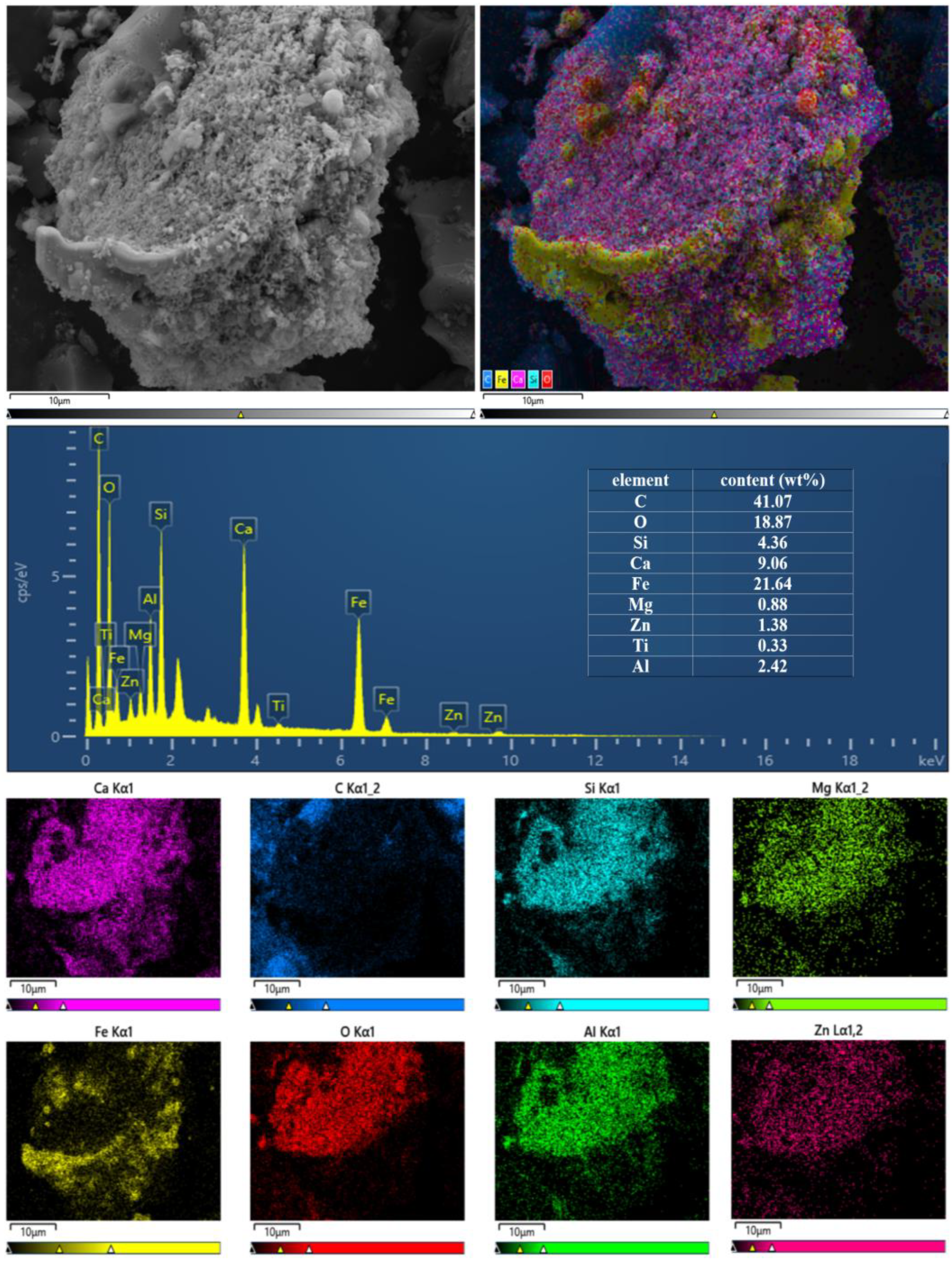
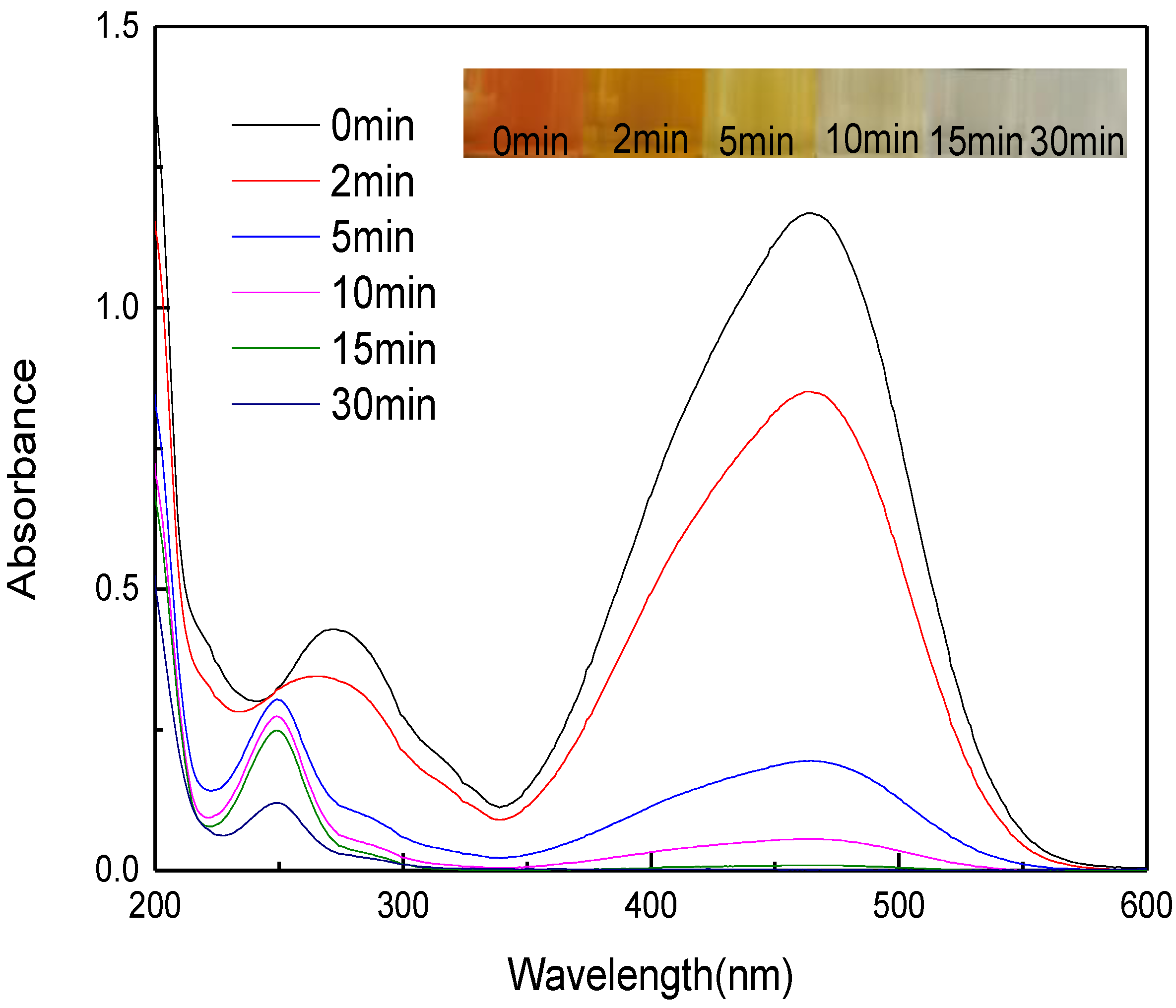
Publisher’s Note: MDPI stays neutral with regard to jurisdictional claims in published maps and institutional affiliations. |
© 2022 by the authors. Licensee MDPI, Basel, Switzerland. This article is an open access article distributed under the terms and conditions of the Creative Commons Attribution (CC BY) license (https://creativecommons.org/licenses/by/4.0/).
Share and Cite
Zeng, X.; Xie, T.; Zeng, B.; Huang, L.; Li, X.; Huang, W. Synthesis of Micro-Electrolysis Composite Materials from Blast Furnace Dust and Application into Organic Pollutant Degradation. Nanomaterials 2022, 12, 4275. https://doi.org/10.3390/nano12234275
Zeng X, Xie T, Zeng B, Huang L, Li X, Huang W. Synthesis of Micro-Electrolysis Composite Materials from Blast Furnace Dust and Application into Organic Pollutant Degradation. Nanomaterials. 2022; 12(23):4275. https://doi.org/10.3390/nano12234275
Chicago/Turabian StyleZeng, Xiangrong, Ting Xie, Bin Zeng, Lijinhong Huang, Xindong Li, and Wanfu Huang. 2022. "Synthesis of Micro-Electrolysis Composite Materials from Blast Furnace Dust and Application into Organic Pollutant Degradation" Nanomaterials 12, no. 23: 4275. https://doi.org/10.3390/nano12234275
APA StyleZeng, X., Xie, T., Zeng, B., Huang, L., Li, X., & Huang, W. (2022). Synthesis of Micro-Electrolysis Composite Materials from Blast Furnace Dust and Application into Organic Pollutant Degradation. Nanomaterials, 12(23), 4275. https://doi.org/10.3390/nano12234275




